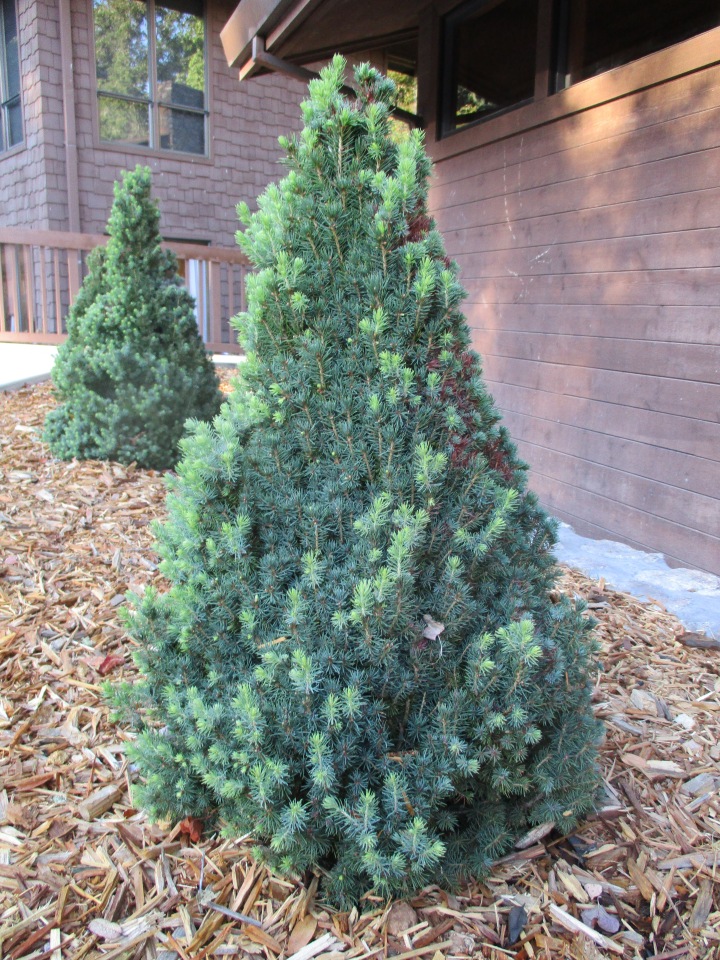 All around town, there are Italian stone pines, Canary Island pines, Monterey pines and Aleppo pines that are much too big for the home gardens that they live in. Some are too close to pavement or foundations. Others are under utility cables. Many are shading or crowding out other more desirable plants. What most have in common is that they started out as living Christmas trees.
All around town, there are Italian stone pines, Canary Island pines, Monterey pines and Aleppo pines that are much too big for the home gardens that they live in. Some are too close to pavement or foundations. Others are under utility cables. Many are shading or crowding out other more desirable plants. What most have in common is that they started out as living Christmas trees.
Because they seem to be so cute and innocent when they are decorated in a small pot, living Christmas trees very often get planted where they really do not belong. Not much consideration is given to their true potential. Pines are innately difficult to contain, and can not easily be pruned back for confinement once they get growing in a space that is not spacious enough for them.
Living Christmas trees simply are not often the horticulturally responsible option for Christmas trees that we would like to believe that they are. Very few end up in good situations where they have room to grow. Planting them in the wild is not practical, since their roots are too confined to survive without watering. Because they are not native, they should not be planted in the wild anyway.
Contrary to popular belief, the most popular of the living Christmas trees do not do well in containers long enough to function as Christmas trees for more than just a few years. Some spruces and small pines can be happy in containers for many years, but can be demanding. If their roots get too disfigured, they are less likely to adapt to the landscape when they outgrow containment.
Ironically, cut Christmas trees are usually more practical than living Christmas trees. They may seem to be expensive, but they are less expensive than living Christmas trees of good quality (unless a living Christmas tree functions for a few years.) Even though they are bigger, cut Christmas trees are not as heavy and unwieldy as the big tubs of soil needed to sustain living trees.
Cut Christmas trees are not harvested from forests, but are grown on farms like any other horticultural commodity. There should be no guilt associated with bringing one into the home. In the end, they can be composted or otherwise recycled like green-waste. There is no long term commitment, and no need to provide accommodations for an eventually humongous tree in the garden.
Those who insist on procuring a living Christmas tree should choose responsibly, and be ready to accommodate a growing young tree. Although not big enough to be real Christmas trees, dwarf Alberta spruce like those in the picture above are sometimes decorated as a small live Christmas tree. They happen to be conducive to confinement in proportionate pots. One in the ground, they grow like strictly conical shrubs that do not get big enough to cause problems.
Down here, Christmas trees often are used to build up dunes, or serve as underwater fish havens. Volunteers collect and place them, and everyone’s happy.
LikeLiked by 1 person
Ours just get ground and composted with greenwaste. Volunteers used to collect and plant living Christmas trees into parks and public spaces, but it was too much work for trees that were not good for much. I mean, they can accommodate only a limited number of stone pines!
LikeLiked by 1 person
You make a good case.
LikeLiked by 1 person
Well, I am an arborist. I work with many trees that were planted into the wrong situations. The family of friends in San Jose planted their living Christmas trees annually for only six years before they noticed that the first one was already becoming a problem after only six years. They waited a few more years before getting all six cut down. It was very expensive.
LikeLike
I am rather boring. My Christmas tree is fake 😦 I gave up with real ones because the pine needles were a pain. And now in Portugal, I don’t think I’ve even seen a real one, I must find out what the Portuguese prefer
LikeLiked by 1 person
I do without a Christmas tree. There are plenty of them in other people’s homes . . . and everywhere else. There are fake trees in my neighborhood, even though we are surrounded by Christmas tree farms.
LikeLiked by 1 person
I love dwarf Alberta spruce, they are hardy here so used lots in our landscapes. I have several in (large) pots and several in my gardens to lend winter interest amongst the perennials. They look beautiful with snow on them!
LikeLiked by 1 person
They were way too trendy through the 1980s, and often ended up in situations where they were not happy. In just a few years, they went from being distinctive and somewhat rare, to common and cheap. Now that they have been less than trendy for a while, they are becoming respectable again. I always liked them, but did not want to use them until recently.
LikeLiked by 1 person
I feel that way about hostas, too common and overused. I tend to be a bit of a plant snob LOL
LikeLiked by 1 person